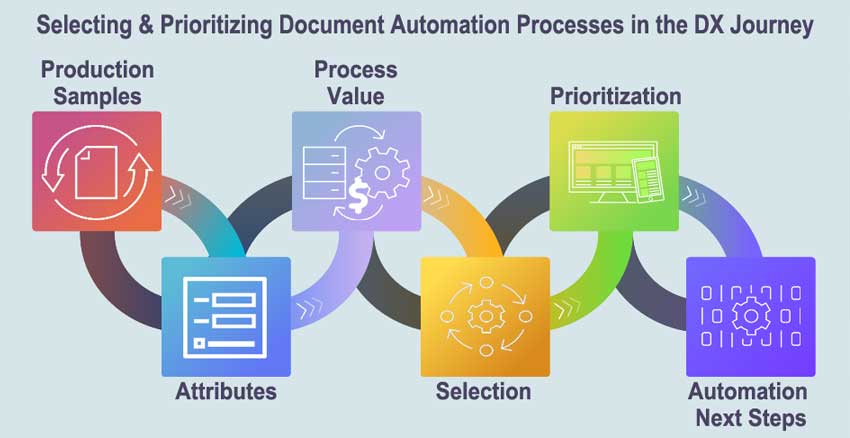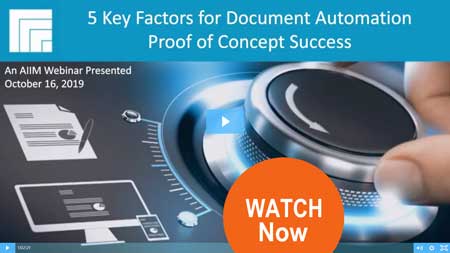 Selecting and prioritizing document automation processes is a critical step in the digital transformation (DX) journey. In the third installment of our DX series, we discuss what attributes make a process more suitable for document automation in the DX journey and how to prioritize them.
Selecting and prioritizing document automation processes is a critical step in the digital transformation (DX) journey. In the third installment of our DX series, we discuss what attributes make a process more suitable for document automation in the DX journey and how to prioritize them.
Previous articles in our DX series include: “Digital Transformation & Its Document Automation Challenge” and “What It Means to be Digitally Transformed.”
The Digital Transformation Journey
Why do organizations want to be digitally transformed? It all boils down to the desire to become more customer-centric in a way that enables an organization to capture more of today’s market spend at higher profit margins and position it to take advantage of future market opportunities. This means faster, more-flexible and controllable processes, but without the traditional costs. It means greater access to information across the organization. It also means real-time, 24×7 work.
All of this ultimately leads to the word, digital, which translates to doing things in real-time, relying less on activities that are carried out in the physical world and relying more on those that are computerized. There are certain attributes that make a process more suitable for document automation within digital transformation over others or place it higher on the list of priorities.
When it comes to moving document-oriented processes into the digital realm, careful consideration should be taken on the nature of the process and of the data involved to ensure that the optimal amount of automation can be realized. After all, document automation should support an overall objective to make processes more reliable, faster and less costly.
Key Attributes in Selection & Prioritization
Production Samples
The first attribute to examine is the availability of data associated with the process. Proper configuration of automation requires a sizable amount of data to be analyzed to accommodate the various document attributes involved. Rarely are there cases where even the same document type is standardized to the degree that production samples are exactly the same in terms of layout and data. If an organization uses documents scanned and supplied by others, then there can be significant differences that need to be anticipated. The good thing is that organizations often have a large amount of documents in systems of record that can be used to support these needs.
Document-level Attributes
The second attribute to examine, which is related to the first, is document-level attributes, specifically the amount of variance in both data type and layout. The invoice is the favorite example of potentially high variance of both location of data as well as the range of values of data. The higher the variance of a particular document type involved in a given process, the more difficult it is to achieve high-levels of automation. Processes that involve structured forms are the best in terms of simplicity of configuration to achieve significant automation.
Process Value
The third attribute is process value. While it may be easy to automate an employee onboarding process that includes processing various documentation, it may not be high value when compared with processes associated with generating revenue or new business opportunities. Therefore, the time and expense taken might not have as high a payoff as processes core to a business that are typically higher-value than operational or peripheral processes. On the other hand, if the data involved in a high-value process is complex, it might be risky to select a high value process first in a digital transformation effort.
Establishing a Framework
With the three attributes above, it is possible to establish a framework that has the attributes on the Y axis and processes (e.g. low, medium, high) running across the x axis with cells filled with relative scores such as “low”, “medium”, and “high” as below:
| Process 1 | Process 2 | Process 3 | |
| Data Availability | Low | High | Medium |
| Document Complexity | High | Low | Medium |
| Process Value | Medium | High | High |
Once laid-out in this manner, we can see that Process 2 would be a logical choice to apply document automation as the availability of training data is high as is the process value while the complexity of the document-based information is low.
Automation | Next Steps
With document automation supporting a DX journey, it is always important to consider multiple aspects or attributes at a process-level in order to properly identify candidate processes for transformation as well as to set realistic objectives.
This on-demand AIIM webinar with guest speaker Rich Medina, Co-Founder of Doculabs, focuses on how to properly scope a Document Automation Proof of Concept: what you need to in terms of preparation, how to identify the right participants, what to do with the results, and the next steps you should take.

